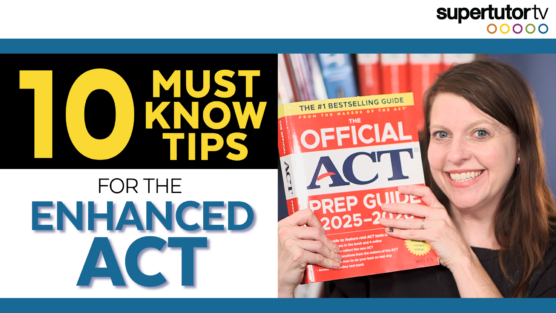Taking the Math SAT® Subject Test? Here are some tips on how to prep for math success!
First let’s clarify some things. Which level test should you take? Competitive colleges like to see the level II tests – so taking Math Level II would be ideal. If you haven’t gotten to pre-calculus yet, then Math level I is the best option for you. Math level I covers through Algebra 2.
How to Study
If you’ve watched my Self Study SAT® or ACT® videos then you’ll find that the process if pretty similar. Let’s get started:
1. Take A Practice Test
Unlike the official SAT®, the SAT® Math Subject Tests don’t have free practice tests from the College Board. There are some free practice questions that you can get but it pretty much stops there.
Solution: Buy a book.
I recommend checking out The Official SAT® Subject Tests in Mathematics Levels 1&2. This book has two full-length, previously administered mathematics tests for each of levels I and II (4 tests total!).
Take a test. Time it. Grade your practice test!
2. Go over wrong answers
Go over everything you missed and make a list of ALL the areas you need to brush up on: rational expressions, matrix multiplication, logs, conics, etc. Think of it as a laundry list of areas for you to review.
3. Get Old Math Textbooks
Unlike the SAT® and ACT® math sections, this test has a closer resemblance to the kind of questions you would see in your math class. To better brush up, it often helps to actually go back to your old math books and use these as another study source. If you no longer have access to these math books, no worries. There are several ways to get a copy of some math book that will have some odd answers in the back of the book, some decent explanations, and enough material to get you back into shape.
Where to get old math books:
Brothers and Sisters: Do they have these books? Can you borrow?
School Library : Your library might have copies of the exact book you used. Some schools allow you to check them out like a regular library book.
Math Teacher: Your current (or previous) teacher might be willing to loan you a copy
Public Library: Even if it doesn’t have your exact textbook, chances are it will have some textbook that will work.
Amazon: You might be able to get a cheaper older edition. Most math books change little from edition to edition. If you go for say the 2012 edition, you may be able to get a used textbook for under $7-10 with shipping.
Google: You might find free textbooks written by teachers or even from some publishers. Type the name of the book you’re looking for and filetype:pdf.
Now once you have your math books, take that list, and go back to the sections in those books that correspond with the sections covered on the test. Read the book chapters, run the example problems and make yourself sit and do the odds at the back of the chapter– using the back of the book to check your work. Drill yourself so you can get your math skills in top shape!
4. Take More Mock Tests
After your initial test, work on your problem areas, then take another practice test, and repeat the process.
Practice is key. You may also want to turn to traditional prep resources – books written specifically for the Mathematics Level I & II test. The College Board guide doesn’t coach you on strategy. You’re going to need to seek out other brands and other authors if you’re looking for strategy and tips specific to the exam.
What’s the best book?
Unfortunately, most test makers haven’t crafted the “perfect” prep book for this test. There are only two released Math Subject Practice Tests, so there’s only a really small sample set of problems to base prep materials on– and so different brands are guessing at what’s going to be on the test. What you can use to your advantage is the fact that they all guess a little bit differently. The best thing for you is to mix up your brands – cover all your bases. Get one or two books from an independent tutor and one or two books from more known brands. You want to have a few different sources of practice tests.
Some books also have drills that are separated by question type– this is another way you can work on your “problem areas.” Generally the independent tutor books are more likely to have this format– it’s one of my favorites. I try to find one book with drills and another couple with tests so that prep is well rounded.
Study Plan Recap
1. Take a practice test
2. Go over wrong answers
3. Learn from your wrong answers (and study those areas in your math or other books)
4. Take another practice test
5. Rinse and repeat
Good Luck!




